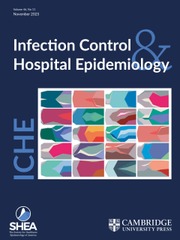Article contents
Methicillin-Resistant Staphylococcus aureus in U.S. Hospitals, 1975–1991
Published online by Cambridge University Press: 21 June 2016
Abstract
Analyze changes that have occurred among U.S. hospitals over a 17-year period, 1975 through 1991, in the percentage of Staphylococcus aureus resistant to b-lactam antibiotics and associated with nosocomial infections.
Retrospective review. The percentage of methicillin-resistant S aureus (MRSA) was defined as the number of S aureus isolates resistant to either methicillin, oxacillin, or nafcillin divided by the total number of S aureus isolates for which methicillin, oxacillin, or nafcillin susceptibility test results were reported to the National Nosocomial Infections Surveillance (NNIS) System.
NNIS System hospitals.
Of the 66,132 S aureus isolates that were tested for susceptibility to methicillin, oxacillin, or nafcillin during 1975 through 1991, 6,986 (11%) were resistant to methicillin, oxacillin, or nafcillin. The percentage MRSA among all hospitals rose from 2.4% in 1975 to 29% in 1991, but the rate of increase differed significantly among 3 bed-size categories: <200 beds, 200 to 499 beds, and 2500 beds. In 1991, for hospitals with <200 beds, 14.9% of S aureus isolates were MRSA, for hospitals with 200 to 499 beds, 20.3% were MRSA; and for hospitals with >500 beds, 38.3% were MRSA. The percentage MRSA in each of the bed-size categories rose above 5% at different times: in 1983, for hospitals with 2500 beds; in 1985, for hospitals with 200 to 499 beds; and in 1987, for hospitals with <200 beds.
This study suggests that hospitals of all sizes are facing the problem of MRSA, the problem appears to be increasing regardless of hospital size, and control measures advocated for MRSA appear to require re-evaluation. Further study of MRSA in hospitals would benefit our understanding of this costly pathogen.
Information
- Type
- Original Articles
- Information
- Copyright
- Copyright © The Society for Healthcare Epidemiology of America 1992
References
- 297
- Cited by

